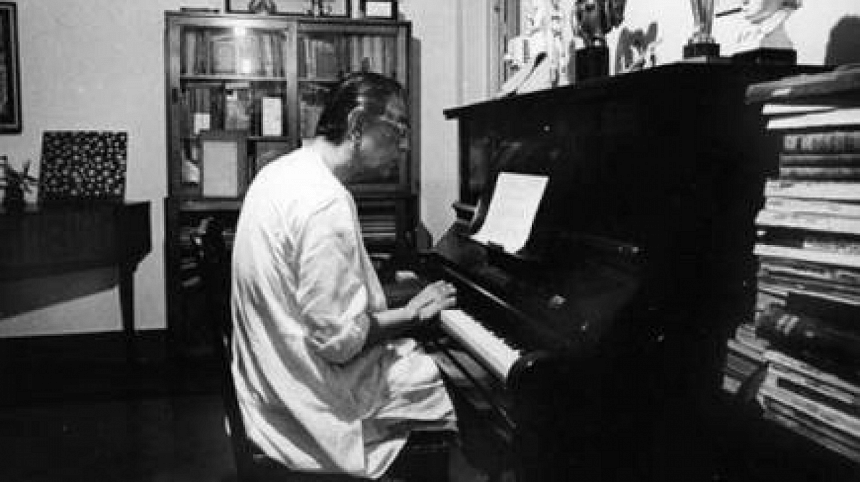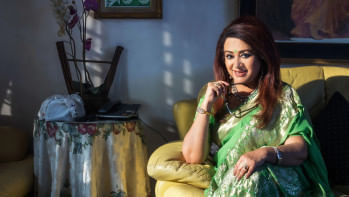From director to musical maestro: Remembering the legendary Satyajit Ray

Today marks the 102nd birthday of Satyajit Ray, one of the greatest filmmakers of all time. While he is known primarily as a masterful storyteller for his films and literary works, Ray was a man of many talents.
Ray's films are not only remembered for the storytelling or the cinematography, rather one unique element that continues to give Ray's films paramount significance is the use of music, sounds, and songs.
The legendary director had a good collection of records and tapes at his primary workstation in his longtime residence at Bishop Lefroy Road in Kolkata, along with piles of magazines and books. On one side of the room, Ray kept a Roland piano, where he used to sit and pick out tunes for his films. At the side of the piano, on top of a window, stood a bust of Beethoven, signifying Ray's praiseworthy fascination with Western Classical music.

As Ray often mentioned in several interviews, his "first love" was music, not film. Born and raised in an atmosphere of music and singing, he was exposed to Western Classical music and Bengali music from a very early age.
Ray's paternal grandfather Upendrakishore Ray Chowdhury was a composer and a violinist, while his maternal grandfather Kalinarayan Gupto was also a composer and singer. According to Ray, everyone on his mother's side of the family was a "natural singer."
In a 1984 documentary, "Music of Satyajit Ray" by Utpalendu Chakraborty, Ray elaborately spoke about his love of music.
"I had heard of Beethoven's and some other Western music from when I was a small boy; I had a toy gramophone and a small collection of records given to me as a birthday present," said Ray in the documentary.

Western music developed into a genuine interest when Ray was a teenager; he was fascinated by Bach, Mozart, Beethoven, and Tchaikovsky, among others.
"When other kids were writing and reading poetry, I was listening to music, reading about composers, compositions, and musical forms," said Ray.
In his first and most famous film, "Pather Panchali" (Song of the Little Road) in 1955, Ray made history by using a classical musician of the stature of sitar maestro Ustad Ravi Shankar, paving the way for using the genre in films.
Other collaborations with brilliant musicians as sitar maestro Ustad Vilayat Khan in "Jalshaghor" (The Music Room) in 1958 and sarod maestro Ali Akbar Khan in "Devi" (The Goddess) in 1960, created a new era of film music in India.

Starting with 'Teen Kanya' (Three Daughters) in 1961, Ray began his journey as a music director till his final film. All his movies since then had a central theme, highlighting the primary narrative of each story.
Though Ray wrote the lyrics of a song in the 1960's film "Devi", his first fully composed song was used in the film "Chiriyakhana" (The Zoo) in 1967. In the voice of Namita Ghosal, the song was titled "Bhalobashar Tumi Ki Jano".
The best way to describe Ray's music is "a unique multi-layered blending of Western sense and Indian sensibility," according to the narrator of the 1984 documentary.
Ray's innovative and most satisfying work as a music director was for the film, "Charulata" in 1964. The entire film features several popular Tagore songs, but Ray's mastery is portrayed in the use of tunes and sounds of these songs, highlighting the emotions in each of the scenes.

Through Kishore Kumar's voice, "Ami Chini Go Chini Tomare," featuring Soumitra Chattopadhyay and Madhavi Mukhopadhyay, is still one of the most iconic scenes in a Bengali film.
The main tune of the film was the famous Tagore number, "Momo Chittey Niti Nrittey Ke Je Naachey". Though the lyrics or the song was never used in the film, Ray used the tune as the background, embedding it into the audience's minds.
Ray's musical genius was later fully reflected in two of his iconic musical films, "Goopy Gyne Bagha Byne" in 1969 and the sequel "Hirak Rajar Deshe" (The Kingdom of Diamonds) in 1980.
The first film, based on his grandfather Upendrakishore's short story, "Goopy Gyne Bagha Byne", features nine songs with music and lyrics written by Ray.
"I started writing some of the songs even before I wrote the scenario; I imagined some of the situations that would occur in the film and wrote songs as a tryout," said Ray in the 1984 documentary. Only when the songs turned out satisfactory, did he decide to make the film.
The audience is amused by a terrified Goopy pleading with a tiger to a raga-inspired melody in "Hirak Rajar Deshe", while the famous dance of the ghosts in "Goopy Gyne Bagha Byne" portrays masterful use of traditional percussion instruments.
"Maharaja, Tomare Selam", "Aha Ki Anondo Akashe Batashe", "Ek Je Chilo Raja", "Eshe Hirak Deshe", and "Dekhore Nayan Mele" are some of the several masterpieces from these two films.
The classic and iconic Feluda theme, which was used in Ray's "Sonar Kella" (The Golden Fortress) in 1974 and "Joi Baba Felunath" (The Elephant God) in 1979, was later used in every Feluda adaptation till now.
Ray experimented with mixing Western and Indian music elements for the first time in the film, "Ghare Baire" (The Home and the World) in 1984. In his final film, "Agantuk" (The Stranger), in 1991, Ray himself lent his baritone to the score, singing a few lines from a song.
It was not just about Ray's genius as a composer; his use of background scores, tunes, and sounds in each film was unique and brilliant. No other film director has quite matched the command of music and score writing he had, even now.
The background music in Ray's films perfectly portrayed his characters' emotions, moods, and shades. However, Ray's mastery also lay in using natural sounds and especially in his use of silence. Even with no music or background scores, Ray used silence as a powerful indicator of a character's emotional journey.
While birds singing in the background are conventional scores, Ray used much more intricate sounds, such as tearing up a paper, the sound of swings, squishing sounds of writing, or even the sounds of running in a field, which makes the audience completely immerse themselves in the films.
Ray's specialty was relatable, functional, and yet imaginative use of sounds and music, rather than melodramatic and elated music used in most films at the time. In an era where modern technology was not predominantly used in films, Ray was way ahead in creating music that transcended time and generations to come.
Ray always wanted to work as an independent composer; in his own words, "I love composing songs and background music, and that is why I do it," said Ray in 1984. "This is going to be a rule, for now, and the future, that I shall work only for myself."
Ray's compositions have been used in multiple productions around the world. For example, American director Wes Anderson used several of Ray's original compositions, including the theme from "Charulata" in his film, 'The Darjeeling Limited', in 2007.
Ray will forever be remembered as a prolific storyteller, on and off screen; still, his musical persona, reflected boldly in his films, makes him the multifaceted genius who revived and revolutionised Bengali films worldwide.
On the master storyteller's birthday, we again honour him with his own words -- "Maharaja Tomare Selam."

 For all latest news, follow The Daily Star's Google News channel.
For all latest news, follow The Daily Star's Google News channel. 




Comments